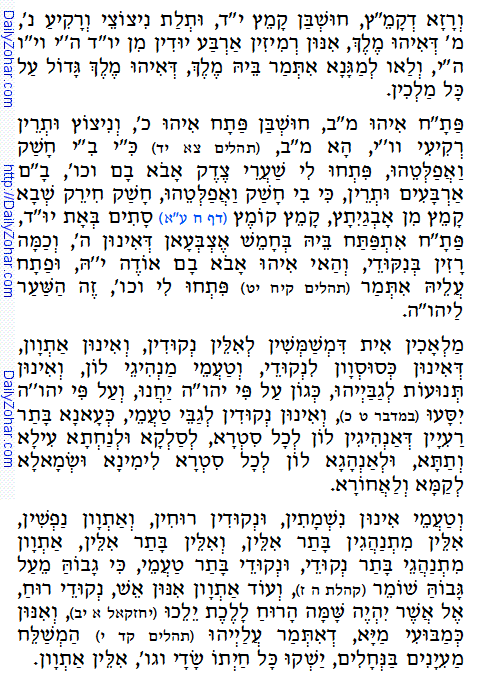
The letters of the Torah are vessels at the level of Nefesh, the sparks of Light of the vessel are the
Nikkud (dots, “vowels”), which is in the level of Ruach and the
cantillation is the light in the level of
Neshama.
Example of Hebrew Nikkud. Cantillation marks are in blue.
The upper three Sefirot
Keter,
Chokmah and
Binah has the Nikkud of Kamatz (קמץ (ָ, Patach (פתח (ַ and Tzeire צרי (ֶ..). The numerical value of them is 42. The Kamats built from horizontal line and a dot under it. A line has the value of 6 and the dot is 10. Patach is 6 and Tzeire with the two dots is 20. The Kamatz has the line as the Keter or the border between the unknown and the whole spiritual system we are in below. The dot of the Kamatz is the middle point from it the world was created.
The Patach, meaning opening in Hebrew פתח is the Level of Chokmah, the parallel line to the Kamatz that continued the unrestricted Light form Keter to Binah.
Tzeire צרי, the root word for “to form”, is Binah, which is the force of creation. Binah received the thought of Keter, which is the name of 42 letters, known as the Ana B’Koach that created the whole existence.
With Chokmah as a partner as represented by the two dots, they gave birth to
Zeir Anpin.
A short note about יצירה “To form”.
The creator created the world in one thought and one word (of 42 letters). The rest is considered as formation of the existing energy.
We can never “create” new in this world. We can only form a new thing from existing energy/matter.
Even the latest electronic gadgets are basically a transformation of other materials. The most sophisticated computer chip is made from silicon (sand), plastic (natural polymer) and dust of the earth (metals). The new ideas that pop in our mind come from Keter and Chokmah.
The Hebrew word המצאה, “Invention” comes form the word מצא “to find”. The word “Invent” comes from Latin and it means “to find”. Everything is there, all we need is to find it.
——–
The Hebrew line below is a reference to the Hebrew text in the actual Zohar book. There is no English book for the text of Tikunei Zohar, which is the source for the Daily Zohar.
מקור הקטע: הקדמת תיקוני הזוהר עם פרוש מעלות הסולם (רבי יהודה צבי ברנדויין זל) פסקה 166



 Previous: Tikunim
Previous: Tikunim

